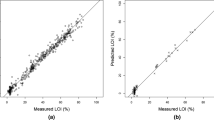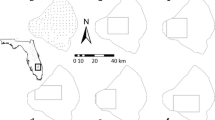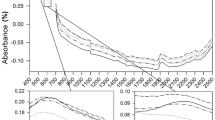Abstract
Sediments are typically analyzed for C, N, and P for characterization, sediment quality assessment, and in nutrient and contaminant studies. Cost and time required for analysis of these constituents by conventional chemical techniques can be limiting factors in these studies. Determination of these constituents by near-infrared reflectance spectroscopy (NIRS) may be a rapid, cost-effective method provided the technology can be applied generally across aquatic ecosystems. In this study, we explored the feasibility of using NIRS to predict total C, CO3 −2 organic C, N, and P in deep-water sediment cores from four Canadian lakes varying over 19 degrees of latitude. Concentration ranges of constituents in the samples (dry weight basis) were total C, 12-55; CO3 −2, 6-26; organic C, 7-31; N, 0.6-3.1; and P, 0.22-2.1 mg g−1. Coefficients of determination, r2, between results from conventional chemical analysis and NIR-predicted concentrations, based on calibrations across all the four lakes, were 0.97-0.99 for total C, organic C, and N. Prediction for CO3 −2 was good for the hard water lake from a calibration across all four lakes, but this constituent in the three soft water lakes was better predicted by a calibration across the soft water lakes. The NIR calibration for P fell below acceptable levels for the technique, but proved useful in the identification of outliers from the chemical method that were later removed with the re-analysis of several samples. This study demonstrated that NIRS is useful for rapid, simultaneous, cost-effective analysis of total C, CO3 −2, organic C, N, and P in dried sediments from lakes at widely varying latitudes. Also, this study showed that NIRS is an independent analytical tool useful for the identification of outliers that may be due to error during the analysis or to distinctive composition of the samples.
Similar content being viewed by others
References
Batten, G. D., P. Flinn, L. A. Welsh & A. B. Blakeney (eds), 1995. Leaping Ahead with Near-infrared Spectroscopy–Proceedings of the Sixth International Conference on Nearinfrared Spectroscopy, Lorne, Victoria, Australia, April, 1994.
Davies, A. M. C. & P. Williams (eds), 1996. Near Infrared Spectroscopy: The Future Waves. Proceedings of the Seventh International Conference on Near-infrared Spectroscopy, Montreal, Quebec, Canada, August, 1995. NIR Publications, Chichester, U.K., 742 pp.
Environment Canada, 1994. Guidance Document on Collection and Preparation of Sediments for Physicochemical Characterization and Biological Testing. Technology Development Directorate, Environment Protection Series Report EPS 1/RM/29, Ottawa, ON, Canada, 132 pp.
Findlay, D. L., H. J. Kling, H. Ronicke & W. J. Findlay, 1998. A paleolimnological study of eutrophied Lake Arendsee (Germany). J. Paleolim. 19: 41–54.
Korsman, T., M. B. Nilsson, K. Langren & I. Renberg, 1999. Spatial variability in surface sediment composition characterised by near-infrared (NIR) reflectance spectroscopy. J. Paleolim. 21: 61–71.
Korsman, T., M. Nilsson, J. Ohman & I. Renberg, 1992. Nearinfrared reflectance spectroscopy of sediments: A potential method to infer the past pH of lakes. Environ. Sci. Technol. 26: 2122–2126.
Lockhart, W. L., P. Wilkinson, B. N. Billeck, R. A. Danell, R. V. Hunt, G. J. Brunskill, J. Delaronde & V. St. Louis, 1998. Fluxes of mercury to lake sediments in central and northern Canada inferred from dated sediment cores. Biogeochemistry 40: 163–173.
Lockhart, W. L., P. Wilkinson, B. N. Billeck, R. V. Hunt, R. Wagemann & G. J. Brunskill, 1995. Current and historical inputs of mercury to high-latitude lakes in Canada and to Hudson Bay. Wat. Air Soil Poll. 80: 603–610.
Malley, D. F., 1998. Near-infrared spectroscopy as a potential method for routine sediment analysis to improve rapidity and efficiency. Wat. Sci. Technol. 37: 181–188.
Malley, D. F., H. Rönicke, D. L. Findlay & B. Zippel, 1999. Feasibility of using near-infrared reflectance spectroscopy for the analysis of C, N, P, and diatoms in lake sediments. J. Paleolim. 21: 295–306.
Malley, D. F. & P. C. Williams, 1997. Use of near-infrared reflectance spectroscopy in prediction of heavy metals in freshwater sediment by their association with organic matter. Environ. Sci. Technol. 31: 3461–3467.
Malley, D. F., P. C. Williams, B. W. Hauser & J. Hall, 1996. Prediction of organic carbon, nitrogen and phosphorus in freshwater sediments using near infrared reflectance spectroscopy. In Davies, A. M. C. & P. Williams (eds), Near Infrared Spectroscopy: The Future Waves. NIR Publications, Chichester, U.K., 691–699.
Malley, D. F., L. Yesmin, R. G. Eilers & P. Haluschak. Feasibility of analyzing archived Canadian Prairie agricultural soils by near-infrared reflectance spectroscopy. Proceedings of the 9th International Conference on Near-Infrared Spectroscopy: Towards the Third Millennium, 13–18 June 1999, Verona, Italy (in press).
Nilsson, M. B., E. Dåbakk, T. Korsman & I. Renberg, 1996. Quantifying relationships between near-infrared reflectance spectra of lake sediments and water chemistry. Environ. Sci. Technol. 30: 2586–2590.
Rosenberg, D. M., T. B. Reynoldson, K. E. Day & V. H. Resh, 1998. Role of abiotic factors in structuring benthic invertebrate communities in freshwater ecosystems. In Ingersoll, C. G., T. Dillon & G. R. Biddinger (eds), Ecological Risk Assessment of Contaminated Sediments, chapter 10. SETAC Press, Pensacola, FL, USA, 135–155.
Stainton, M. P., M. J. Capel & F. A. J. Armstrong, 1977. The chemical analysis of fresh water. 2nd ed. Can. Fish. Mar. Serv. Spec. Publ. 25: 180 pp.
Starr, C., A. G. Morgan & D. B. Smith, 1981. On evaluation of near-infrared reflectance analysis in some plant breeding programmes. J. Agric. Sci. 97: 107–118.
Williams, P. C. & K. H. Norris, 1987. Near-infrared Technology in the Agricultural and Food Industries. American Association of Cereal Chemists Inc., St. Paul, MN, USA, 330 pp.
Author information
Authors and Affiliations
Rights and permissions
About this article
Cite this article
Malley, D., Lockhart, L., Wilkinson, P. et al. Determination of carbon, carbonate, nitrogen, and phosphorus in freshwater sediments by near-infrared reflectance spectroscopy: Rapid analysis and a check on conventional analytical methods. Journal of Paleolimnology 24, 415–425 (2000). https://doi.org/10.1023/A:1008151421747
Issue Date:
DOI: https://doi.org/10.1023/A:1008151421747




